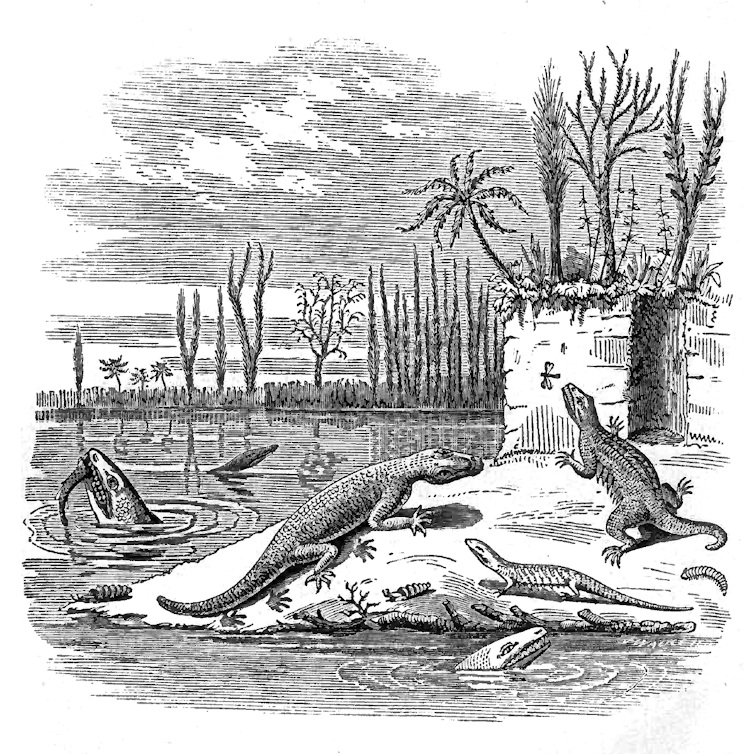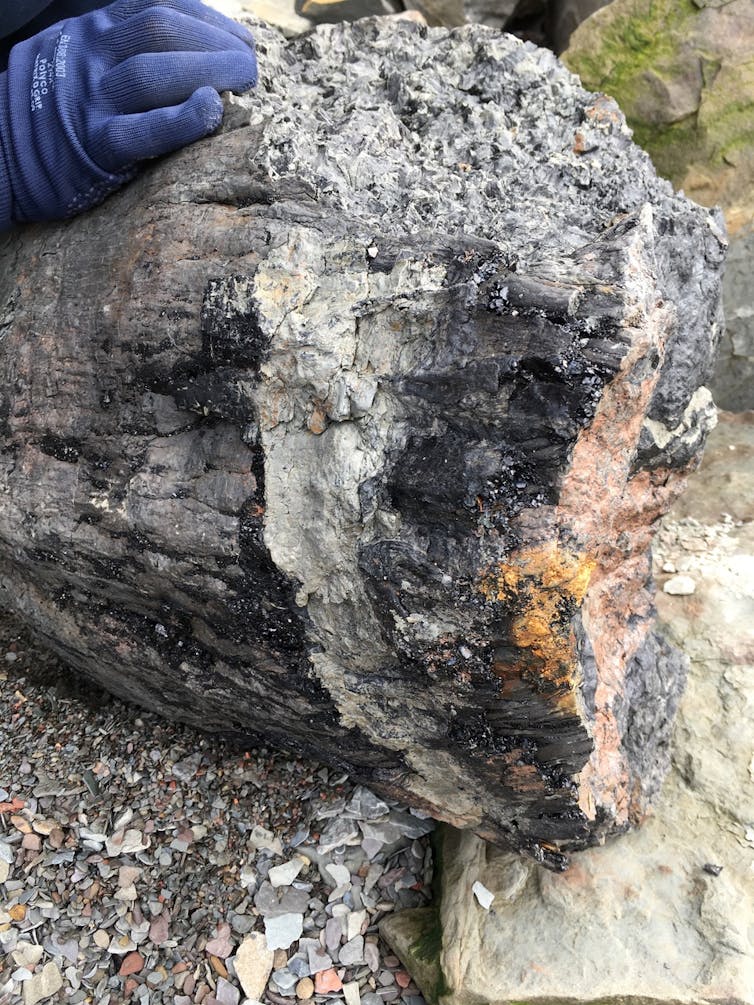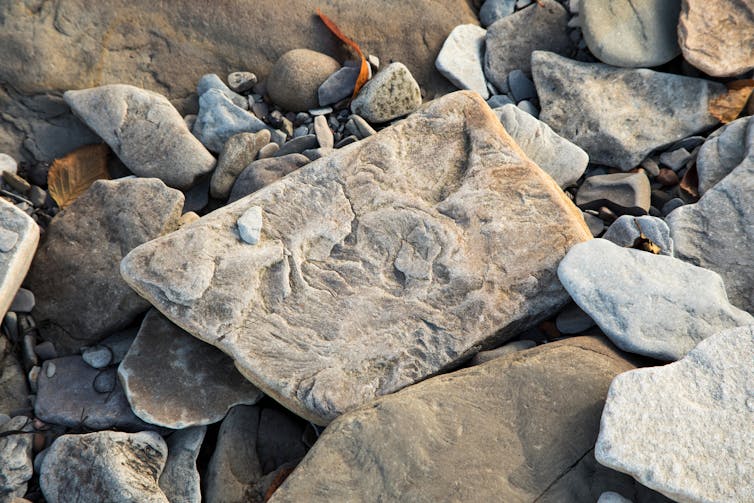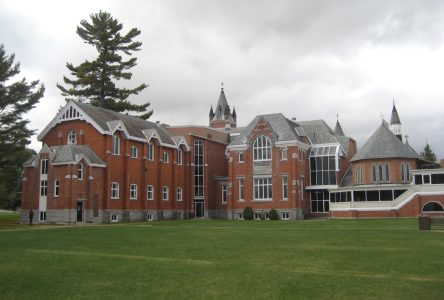
Shutterstock
Over 150 years ago, geologist Sir William Dawson made an astounding discovery in the Joggins Cliffs, along the shores of Nova Scotia’s Bay of Fundy. Within the lithified remains of a giant tree-like plant were the bones of a tiny, 310 million-year-old animal.
This animal was unlike any other seen thus far. It was able to venture where no vertebrate (back-boned) animal had ventured before, deep into the lycopsid forests, away from the water’s edge. This was all thanks to an evolutionary innovation: the amniotic egg.
Although animals had previously ventured onto land in the earlier Devonian Period, animals with an amniotic egg — such as modern reptiles, birds and yes, even mammals — do not need to return to the water to reproduce, as modern amphibians still do. The amniotic egg is a self-contained pond, where the embryo and all its food and waste are stored surrounded by a protective, desiccation-resistant shell.

Dawson Brothers.
This new kind of animal, that Dawson would name Hylonomus lyelli, remains the earliest amniote in the fossil record. Since then, many other animals, some strange and some familiar, have been added to the list of discoveries at Joggins Cliffs at the Bay of Fundy. These include microsaurs, temnospondyls and Dendrerpeton acadianum.
In 2008, the Joggins Fossil Cliffs were designated a UNESCO World Heritage Site. And the cliffs haven’t ceased sharing their secrets — each colossal tidal cycle erodes and exposes more of the ancient ecosystem that once thrived in its formerly equatorial location.
Ancient records
The initial discovery of the paleontological significance of Joggins took place in 1842, when British geologist Sir Charles Lyell travelled to Nova Scotia. Ten years later, Lyell and local geologist Sir William Dawson together studied the strata of the 310 million-year-old cliffs. Within the cliffs stood the bodies of giant trees, frozen in time. However, these trees are unlike those in forests today. Rather they were ancient, giant lycopsids that would have towered 20 to 30 metres above the forest floor.
These lycopsids are what make Joggins in particular critical to our understanding of early tetrapod evolution. That’s because when they died, their soft inner cores rotted away, leaving behind their firm outer bark and a hollow interior. It’s within these hollowed-out stumps that animal remains were trapped and protected for over 300 million years, and where we find them today.
New discoveries
I’m not going to lie: significant fossil finds at Joggins are few and far between. But it’s the unparalleled potential of the next big discovery that keeps me coming back to the site year after year. And we may now have the best chance of that next big discovery.
After a back-breaking, 15-year collaborative effort between the Nova Scotia Museum, Saint Mary’s University, Nova Scotian geologist John Calder, the Joggins Fossil Institute and Joggins native Brian Hebert, a new collection of giant fossiliferous trees — representing the largest collection amassed since the site was discovered — is ready for fresh eyes.

Hillary Maddin, Author provided
Over the next number of years, meticulous manual preparation will reveal tiny new bones, one by one. What makes the newly discovered material so special is that they were collected from strata lower in the Joggins section than any previous material. The fossils within will become new earliest records of animals that we recognize as members of groups of animals that are still alive today — amphibians, reptiles and mammals — and many that are now extinct. We will see for the first time what these trailblazers looked like, and how many different kinds were present in this early phase of tetrapod evolution.
Tetrapod evolution
These animals will teach us many new things about one of the most important phases in tetrapod evolution: the establishment of the first terrestrial, vertebrate communities. We will analyze their anatomy and, through comparisons with living animals, learn about what these animals may have been doing when they were alive.
For example, we can examine the condition of their teeth to learn about what they might have been eating. With the explosion of terrestrial plants at the time, we can see how long it took before animals became herbivorous, and how their strategies might be similar or alternatively, completely different, from those of modern-day herbivores.
We can also examine their bones to learn about what kinds of activities they were doing in these new environments. We’re seeing evidence at slightly younger Carboniferous localities that animals had already begun diversifying ecologically. We see the first burrowing animals and some possibly arboreal animals (animals who spend most of their lives living in trees).
Were the animals at Joggins already doing these things? If so, we would learn it took relatively little time for animals to exploit the many aspects of their new environment. If not, well then, it will appear as though it took some time for these trailblazers to get their footing in the terrestrial realm.

Shutterstock
Together these discoveries and new analyses will revise our understanding of the Carboniferous Period. No longer will we think of it as a boring, stagnant swamp filled with unspecialized creatures.
A new picture is now emerging, one of a dynamic environment that quickly filled up with animals with many new adaptations and abilities.![]()
Hillary Maddin, Vertebrate Paleontologist, Assistant Professor, Carleton University
This article is republished from The Conversation under a Creative Commons license. Read the original article.



